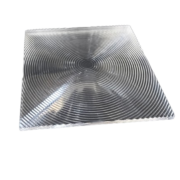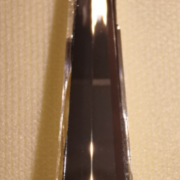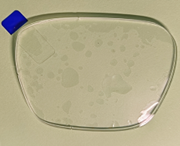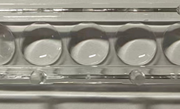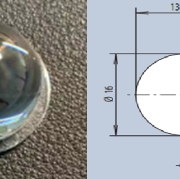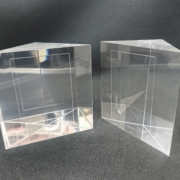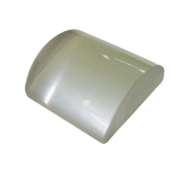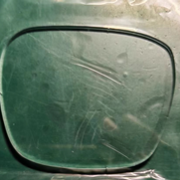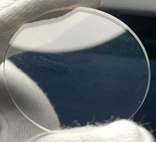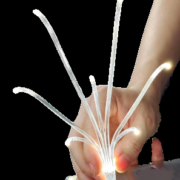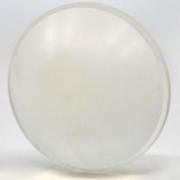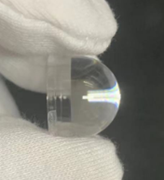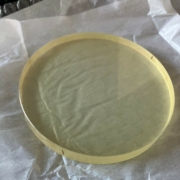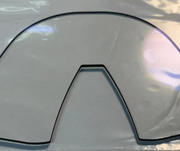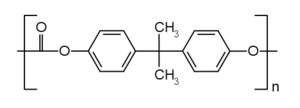Unsere Kunststoff-Optik Projekte
Der Showroom zeigt verschiedene Projekten, die von Sinoptix ausgeführt wurden, verschiedene Kundenanfertigungen, angewendet Glasbeschichtung und Materialien. Es bietet einige beispiele und visuelle Verständnis von einige Optik und Glas Anfragen die wir regelmäßigen für unsere Kunden zur Verfügung stellen.
Wenn Sie wissen wollen, ob wir Ihre Anforderungen behandeln, erfüllen können, dann füllen Sie einfach unser kurzes Online-Formular aus, und wir werden uns in Kürze mit Ihnen in Verbindung setzen.
Bitte beachten Sie, dass eine große Anzahl von Projekten wegen NDA und IP-Schutz nicht im Showroom zu sehen sind.
Optical Plastic :
the right type for the right use
Optical plastic common use
• Optical lenses
• Collimators
• Lenses for mass production
• Camera transparent screen protection
• Mirrors
• Optics for lightning application
Plastics optics Pros & Cons
| Advantage | Disadvantages |
| Very low mass production cost | Tooling fees important (unsuitable for small quantities) |
| Reproducibility of aspherical lenses | More difficult to apply surface treatment |
| Weight (lighter than glass) | Less resistant to outside environment (UV, chemical, heat…) |
| Harder to break (more resistant than glass) | More easily skrachable (softer than glass) |
Plastic optics explained
Two main material are used for optics in plastics : Polymethyl methacrylate (PMMA) or Polycarbonate (PC).
PROPERTIES OF OPTICAL PLASTICS : PMMA & PC
POLY(METHYL METHACRYLATE)
Also called “Acrylic glass”, PMMA is a transparent thermoplastic homopolymer known more commonly by the trade name “Plexiglas.” The material is similar to polycarbonate in that it is suitable for use as an impact resistant alternative to glass(particularly when the high impact strength of PC is not required).
It is generally considered one of the clearest plastics on the market.
PMMA is used for a variety of applications that typically take advantage of its natural transparency and the impact resistance
FOR OPTICAL USE :
Because of its clarity, it is also often used for windows or lenses. The raw material allows for the internal transmission of light nearly in the same capacity as glass which makes it a wonderful substitute.
PMMA is readily available and inexpensive which make a good material option for mass production of lenses.
Moreover, a major useful attribute about thermoplastics like PMMA is that they can be heated to their melting point, cooled, and reheated again without significant degradation. Instead of burning, thermoplastics like Acrylic liquefy, which allows them to be easily injection molded and then subsequently recycled.
Characteristics chart of PMMA
| Characteristic | Data |
| Technical Name | Poly(methyl methacrylate) -PMMA |
| Chemical Formula | (C5H8O2)n |
| Melt Temperature | 130°C (266°F) |
| Thermal resistance | Very good (0.5×10-6 /K) |
| Typical Injection Mold Temperature | 79-107°C (175-225°F) |
| Heat Deflection Temperature (HDT) | 95°C (203°F) at 0.46 MPa (66 PSI) |
| Tensile Strength | 65 MPa (9400 PSI) |
| Flexural Strength | 90 MPa (13000 PSI) |
| Specific Gravity | 1.18 |
| Shrink Rate | 0.2 – 1% (.002 – .01 in/in) |
PROPERTIES OF PC
PC is an amorphous thermoplastic with good transparent properties, but also available in many different colors. The choice for PC is usually made for product requiring transparency, impact resistance along with heat resistance.
Impact resistance comparatively with other commonly used plastic products:
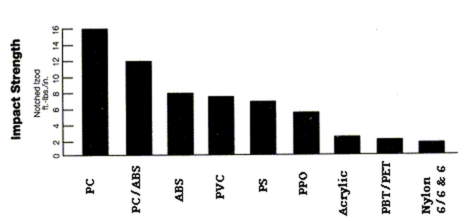
FOR OPTICAL USE:
PC is commonly use for plastic optics through a molding process. Injection molding is a highly efficient method of reproducing optics with complex surface geometries. As a result, optics can be molded in varying volume requirements with a very high degree of part-to-part repeatability. However, due to high mold and set up costs this special process is only interesting for large quantities (usual minimum of 1000 parts).
Coating can also be applied such as AR, individual band pass or protection films.
Characteristics chart of PC
| Characteristic | Data |
| Technical Name | POLYCARBONATE (PC) |
| Chemical Formula | C15H16O2 |
| Melt Temperature | 288-316 °C (550-600 °F) |
| Typical Injection Mold Temperature | 82 – 121 °C (180 – 250 °F) |
| Heat Deflection Temperature (HDT) | 140 °C (284 °F) at 0.46 MPa (66 PSI) |
| Tensile Strength | 59 MPa (8500 PSI) |
| Flexural Strength | 93 MPa (13500 PSI) |
| Specific Gravity | 1.19 |
| Shrink Rate | 0.6 – 0.9 % (.006 – .009 in/in) |

